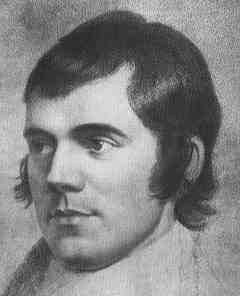Robert Burns (Robert Burns)

Poet. Born the eldest of seven children at Alloway, near Ayr, the son of William Burnes, a small farmer and gardener for the Provost of Ayr. Burns was educated briefly at John Murdoch’s school in Alloway but received most of his schooling at home. His first love, Nelly Kirkpatrick inspired him to try his hand at poetry, and he wrote a song entitled “O, once I lov’d a bonnie lass”, and set it to the tune of a traditional reel. In 1783 he started composing poetry in a traditional style using the Ayrshire dialect of Lowland Scots. When his father died in 1784, Burns and his brother Gilbert rented a farm near Mauchline where they struggled to make a living. During the first decade of his career as a poet, Burns reputedly fathered eight illegitimate children born to five different women. One, Jean Armour, became Mrs. Burns in 1788, two years after the first published work of poetry by Robert Burns “Poems, Chiefly in the Scottish Dialect” was published in July 1786. The Scots dialect had largely fallen into disuse for formal writing but Burns’ revival created a national tradition, and he became most uniquely the poet of his people. Burns moved to Edinburgh in order to dedicate himself to his poetry. A publisher there gave him work editing a collection of Scottish folk songs. The collection, “The Scots Musical Museum”, was published in five volumes. Burns contributed over 150 songs, including “Ae Fond Kiss”, “A Red, Red Rose” and “Auld Lang Syne”. In 1790 he produced what many call his greatest poem, “Tam o’ Shanter” about country folk and their lives. He was asked to furnish contributions for “A Select Collection Of Scottish Airs” by George Thomson. He responded by contributing over 100 songs. In 1795, Burns was inspired by the events of the French Revolution to write “For a’ that and a’ that”. He alienated many of his friends by his enthusiastic support of the French Revolution. His health began to fail, and fell into depression; drinking heavily. Burns died in 1796 of rheumatic fever. He was buried in the churchyard of St. Michael’s in Dumfries, shortly before his wife, Jean, gave birth to their ninth child. Within a short time of his death, money was sent in from all over Scotland in support of his widow and children. Many of Burns’ songs and poems have become international favorites – rare is the year that goes by when “Auld Lang Syne,” for instance, is not heard at least once. (bio by: Iola) Family links: Parents: William Burns (1721 – 1784) Agnes Brown Burns (1731 – 1820) Spouse: Jean Armour Burns (1765 – 1834)* Children: Robert Burns (1786 – 1857)* Francis Wallace Burns (1789 – 1803)* William Nicol Burns (1791 – 1872)* Maxwell Burns (1796 – 1799)* Sibling: Robert Burns (1759 – 1796) Gilbert Burns (1760 – 1827)* *Calculated relationship Inscription:In memory ofROBERT BURNS,who died the 21st July 1796,in the 37th year of his age.ANDMAXWELL BURNSwho died the 25thh of April 1799, aged 2 years and 9 months;FRANCIS WALLACE BURNSwho died the 9th July 1803, aged 14 years. His Sons.The Remains of BURNSRemoved into the Vault below19th Septr 1815. And his two Sons.Also the Remains of JEAN ARMOURRelict of the Poet, born Feby. 1765, died 26th March 1834,And ROBERT, his eldest Son, who died on the 14th May 1857, aged 70 years.
Born
- January, 25, 1759
- Scotland
Died
- July, 07, 1796
- Scotland
Cemetery
- St Michael's Cemetery
- Scotland

